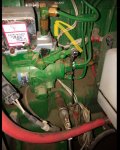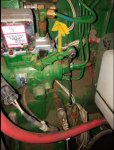That is a return line for the IP.
Ok I am coming up with a plan on that line. As guyf
Oh, forgot to ask Tommy. What line? The fuel or the cable?
Ok seeking wisdom/thoughts on best approach to fix the injector return line to the Electronic control. As you noted earlier it looks as though the return line is out of shape and pinched. It is certainly out if shape. See pic 1.
Due to it being bent it is pulling the line down where it attaches injector 2.
My first temptation is to locate any clamps ,loosen them, and push the line up to allow it to be threaded on straight at the injector 2 attachment point.
Another Option would be to cut the line with a tubing cutter, clean, push the line up above the cut and watch to injector 2. Bend a new line to connect to the cut, using a compression fitting or flare (I think this is low pressure correct) thus eliminating any reduction in flow.
Thoughts? Any other ideas?







